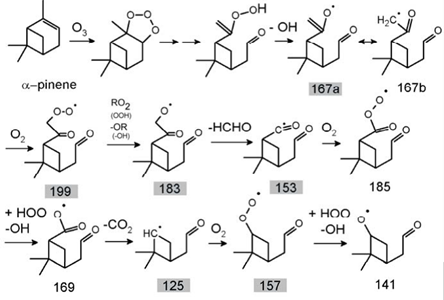Grantee Research Project Results
Final Report: Characterization and Source Apportionment
EPA Grant Number: R832415C001Subproject: this is subproject number 001 , established and managed by the Center Director under grant R832415
(EPA does not fund or establish subprojects; EPA awards and manages the overall grant for this center).
Center: Rochester PM Center
Center Director: Oberdörster, Günter
Title: Characterization and Source Apportionment
Investigators: Hopke, Philip K. , Prather, Kimberly A. , Gelein, Robert
Institution: Clarkson University , University of California - San Diego , University of Rochester
EPA Project Officer: Chung, Serena
Project Period: October 1, 2005 through September 30, 2010 (Extended to September 30, 2012)
RFA: Particulate Matter Research Centers (2004) RFA Text | Recipients Lists
Research Category: Human Health , Air
Objective:
Summary/Accomplishments (Outputs/Outcomes):

| ROS Concentratin | Inhaled ROS | Exposed lenth equals to one Marlboro (red) | ||
|---|---|---|---|---|
| Mainstream smoke | Sidestream smoke | |||
| Source locatin and type | (nmol H2O2/m3-air) | (nmol/hour) | (hours) | (hours) |
| Taipei (Tiwan) sidewalk | 0.54 | 0.19 | 720 | 355 |
| Singapore (Singapore) ambient | 5.71 | 2.06 | 68 | 34 |
| Singapore (Singapore) traffic | 15.10 | 5.44 | 26 | 13 |
| Rubidoux, CA (USA) ambient | 5.89 | 2.12 | 66 | 33 |
| Flushing, NY (USA) ambient | 0.87 | 0.31 | 447 | 220 |
| Rochester, NY (USA) ambient | 8.30 | 2.99 | 47 | 23 |
Table 1 summarizes the particle-bound ROS concentration measured in previous ambient aerosol studies in units of equivalent nmol H2O2 per cubic meter air. According to respiratory parameters, the normal human breathing rate is ~12 breaths per minute with ~half a liter air inhaled per breath. Thus, the ROS concentrations could be converted to the ROS amount inhaled by human breath per hour (also shown in the table). Combined with the data from this study, we can estimate the length of human exposure to ambient air that is equivalent to smoking or being exposed to the sidestream smoke of a Marlboro (red) cigarette. Thus, if one were to continuously breathe ambient air for a total of 2 to 3 days, the resulting ROS exposure would be equivalent to smoking one Marlboro (red) cigarette. Air heavily impacted by traffic is more polluted, and one day of continuous ambient air exposure is equivalent to smoking one cigarette.
Conclusions:
- Better insights have been gained on the formation of endogenous ROS through the formation of secondary organic aerosol (SOA).
- We have been able to show that it is possible to capture and characterize organic free radical species formed in the oxidation of common biogenic VOCs.
- We have shown that the ambient aerosol can induce levels of exposure to particle-bound oxidants similar to exposure to cigarette smoke.
- We have been able to collect highly source impacted samples to provide characterization of particles from specific sources.
Journal Articles:
No journal articles submitted with this report: View all 19 publications for this subprojectSupplemental Keywords:
RFA, Air, Scientific Discipline, Health Risk Assessment, particulate matter, Environmental Chemistry, Biochemistry, chemical characteristics, aerosol composition, airborne particulate matter, atmospheric chemistry, fine particles, human exposure, atmospheric particles, cardiopulmonary responsesProgress and Final Reports:
Original AbstractMain Center Abstract and Reports:
R832415 Rochester PM Center Subprojects under this Center: (EPA does not fund or establish subprojects; EPA awards and manages the overall grant for this center).
R832415C001 Characterization and Source Apportionment
R832415C002 Epidemiological Studies on Extra Pulmonary Effects of Fresh and Aged Urban Aerosols from Different Sources
R832415C003 Human Clinical Studies of Concentrated Ambient Ultrafine and Fine Particles
R832415C004 Animal models: Cardiovascular Disease, CNS Injury and Ultrafine Particle Biokinetics
R832415C005 Ultrafine Particle Cell Interactions In Vitro: Molecular Mechanisms Leading To Altered Gene Expression in Relation to Particle Composition
The perspectives, information and conclusions conveyed in research project abstracts, progress reports, final reports, journal abstracts and journal publications convey the viewpoints of the principal investigator and may not represent the views and policies of ORD and EPA. Conclusions drawn by the principal investigators have not been reviewed by the Agency.
Project Research Results
- 2011 Progress Report
- 2010 Progress Report
- 2009 Progress Report
- 2008 Progress Report
- 2007 Progress Report
- 2006 Progress Report
- Original Abstract
13 journal articles for this subproject
Main Center: R832415
191 publications for this center
144 journal articles for this center
